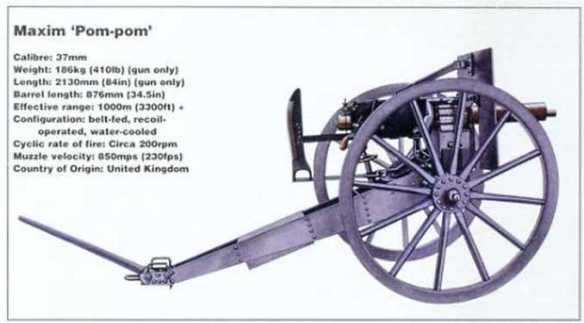MAXIM QF 1-POUNDER “POM-POM”
Pom-pom. So named from the sound of its report, a small-caliber automatic cannon whose reloading mechanism is powered by the firing of each previous round. Developed in the 1880’s and 1890’s by Hiram Stevens Maxim and originally intended as a mounted naval gun, its first use was as a field piece by both the British and the Boers in the Second Boer War (1899-1902). In subsequent naval and antiaircraft use, it was typically mounted in pairs. The British used a 37-millimeter version as a field piece in World War I (1914-1918).
The “Pom-Pom”-so-called because of the noise it made when in use- was an enlarged version of Maxim’s machine-gun. It was the world’s first autocannon-unlike a machine-gun, it fired shells rather than bullets. The “Pom-Pom” served as an artillery weapon and an anti-aircraft gun. Gun on anti- aircraft mounting
A British pom-pom. The performance of these guns in the hands of the Boers convinced the British that they should be using them as well. In later wars they were used against thin-skinned transports, ships and aircraft, (NRA. MFM BW18/5.)
The 1-pounder (1.457-inch/3.7cm) gun that became known, because of the noise of its steady rate of fire, as the Pom-Pom was descended from the hand-cranked guns principally intended for use by the navy. The British soldier was to regret his own army’s lack of interest when he encountered the weapon in the hands of the Boers. They recognised its handiness and mobility in difficult country and used it, after the British had discovered the wisdom of taking cover, less to inflict damage than to restrict movement and prevent the return of fire.
The guns manufactured by the French factory of the American designer Hotchkiss and by the British factory of the Swedish inventor Nordenfelt were turned by hand and thus were vulnerable to, at best, jamming or, at worst, exploding should a round fail to go off promptly. The guns were, absolutely at all times under the control of the officer commanding the battalion.
Royal Navy’s 2 pounder Pom Pom.
This Vickers pom-pom was adopted by the army in 1889 and by the navy in 1892. It was a belt-fed machine gun, the barrel being surrounded by a cooling water jacket. In 1914 these were primarily anti-aircraft guns, and the main difference between the two versions was in their mountings, the HA Mk II (for Mk II) being much steadier, as the revolving pedestal was on rollers rather than a pivot. The AA version was introduced in March 1915. It armed some light cruisers and monitors and many flotilla leaders, destroyers, P boats, river gunboats and lesser warships and auxiliaries, as a defence against low fliers and remote-controlled motor boats (DCBs). Production: 112 Mk I, 785 Mk II. To the end of 1918 deliveries were 701 (including twenty-one for proof or experiments) and 104 for allies (100 Mk II to Italy). Sixteen were transferred to land service for AA.
Ammunition was carried on a 35-round fabric belt, the cyclic rate being 200 rounds/min (each fixed round weighed 2.95lbs). Doctrine was to fire five-round bursts at aircraft and ten-round bursts at DCBs. The calibre was just large enough that shells could be explosive. Approximate barrel life was 5000 full charges, and maximum range was 6900yds at 45° elevation.
2pdr Mks I and II
Nomenclature for 1pdr and 2pdr automatic and semi-automatic guns was assigned in September 1915.
This was a complex, but, extremely reliable weapon, descendant of the 37mm One Pounder Pom Pom of the Anglo-Boer War, basically an enlarged version of the Maxim/Vickers machine guns. Britain also supplied the Boer republics – with the experimental Maxim-Nordenfeldt 1-pdr. machinegun, the ‘pom-pom’. This had a range of only 3,000 yards (1.7m/2.74km) and threw a little shell of 37mm calibre intended to explode on impact. It often failed to do so. However, if hit by one, the victim suffered terrible wounds, but if the shell exploded in the ground it was virtually neutralised and if in the air fragmented inefficiently. The gun was, nonetheless, feared partly because of the speed of fire and partly because it could be taken into places into which other artillery could not go. By the end of the war the British were using them as well. With less modern guns the total strength approached 100 pieces. The Boers also had 30 Maxim-Vickers machine-guns, the precursors of the famous weapon of the First World War, mounted on light carriages.
Subsequently the Royal Navy developed it into an extremely advanced air defence weapon (for its time – 1927) in a eight barrelled mount controlled and fired by one man. The mount’s complexity, especially in reloading resulted in the first use by Britain’s armed forces of work efficiency specialists – the work study practitioners that were in everyone’s way in the 1960’s-70’s. Whilst an efficient weapon system, it suffered from a low rate of fire only 60 sustained rounds per minute per barrel, and if the gun crew became undermanned its effectiveness dropped dramatically. Produced in more effective 4 barrelled mounts during WWII, it was widely used, as was the single barrel mount.
